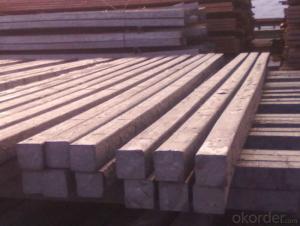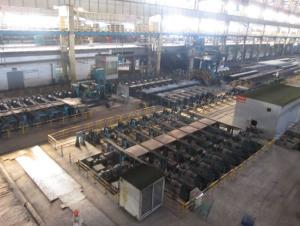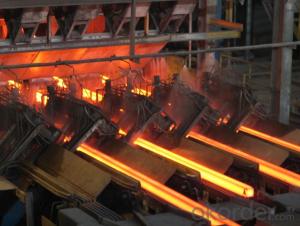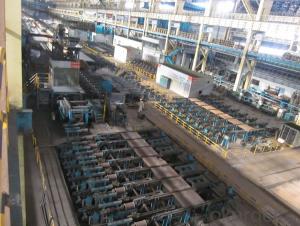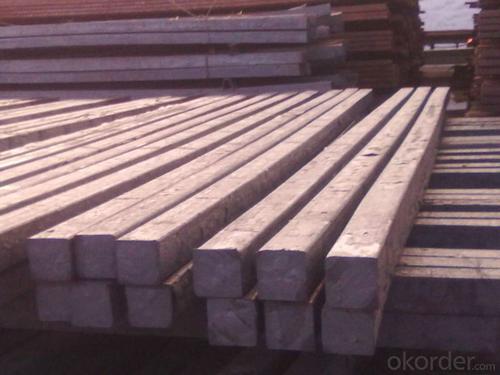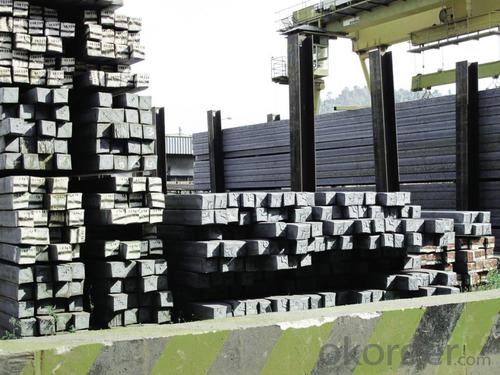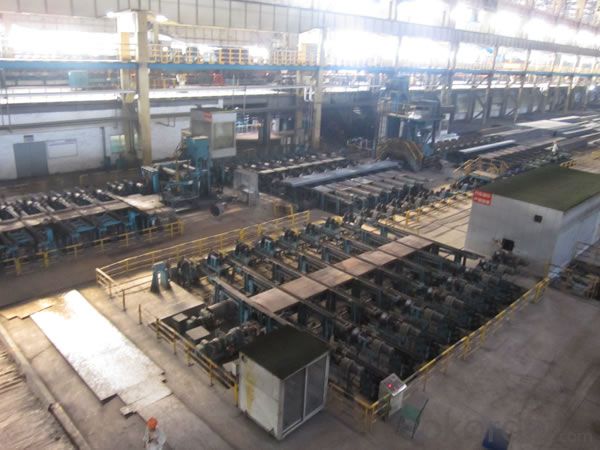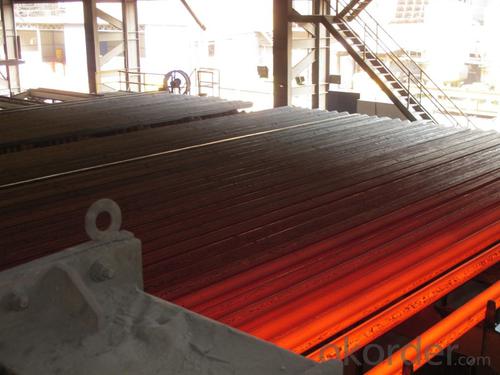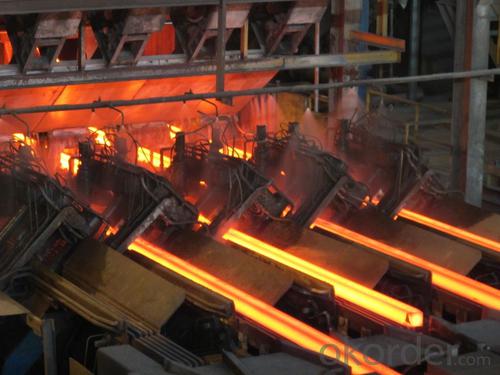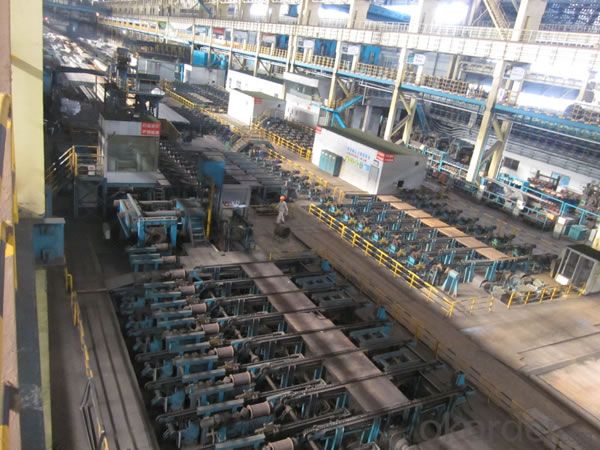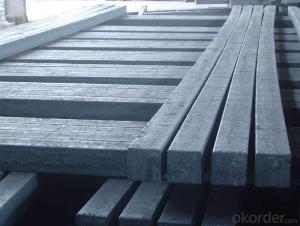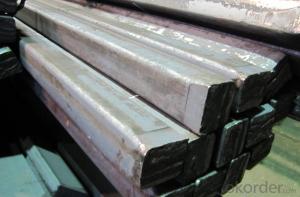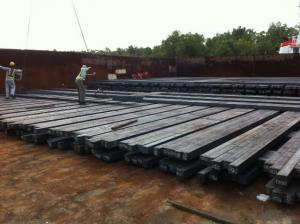Square Steel Billet Q235 3SP Grade Prime Quality 5#
- Loading Port:
- Tianjin
- Payment Terms:
- TT OR LC
- Min Order Qty:
- 2000 m.t
- Supply Capability:
- 50000 m.t/month
OKorder Service Pledge
OKorder Financial Service
You Might Also Like
Description of Square Steel Billet Q235 Grade Prime Quality 5#
M. S. Billets are used for rolling of TMT Re-Bars of Fe415 and Fe500 Grade and various other structural steel products.
CRS Billets are used for rolling of CRS TMT Re-Bars.
Special Alloy Billets are used for rolling of any special grade TMT Re-Bars like Earthquake resistant TMT Re-Bars and for special grade structural steel products.
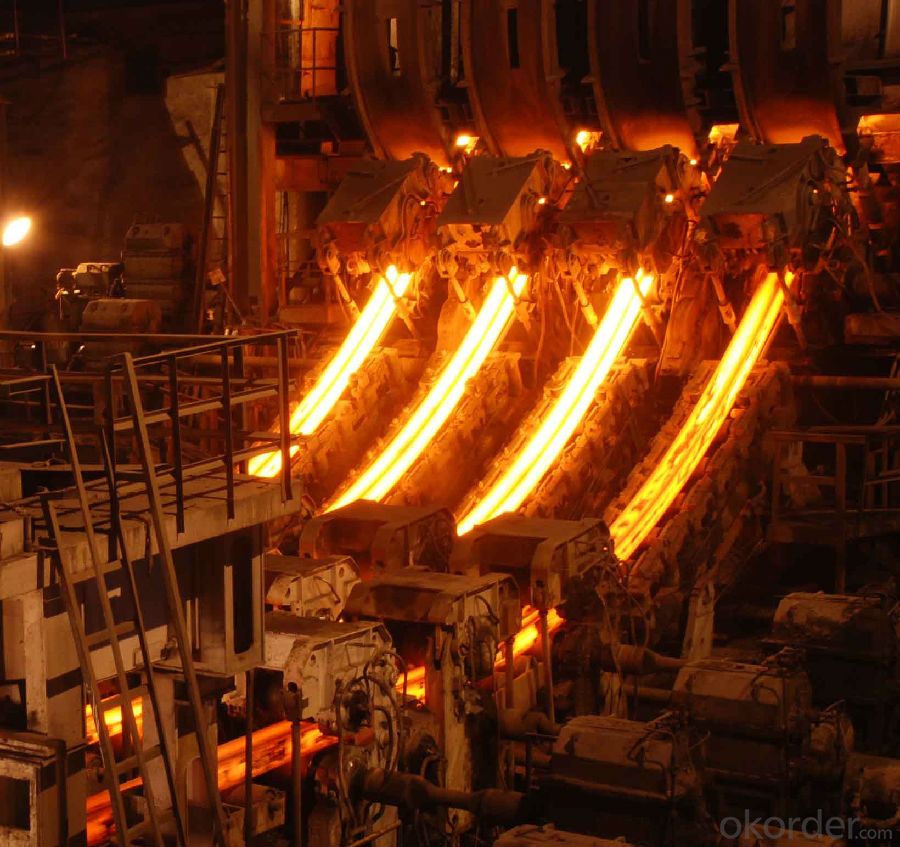
Main Feature Square Steel Billet Q235 Grade Prime Quality 5#
Raw elements(C,Fe,Ni,Mn,Cr,Cu.)---Smelted ingots by AOD finery---hot rolled into black suface---pickling in acid liquid---cold drawn----polished by automatically machine--- cutting into pieces---checking quanlity
Applications of Square Steel Billet Q235 Grade Prime Quality 5#
Widely Used in the areas such as Stainless Steel Fasteners, Chains, Kitchen and Sanitary wares, Furniture handles, Handrails, Electroplating and Electrolyzing pendants, Foods, Electron, Petroleum, Construction and Decoration, etc. Products have a high strength after cold-working. Electronic products parts, Medical appliance, Springs, Bus Inside and Outside packaging and building, Street Lamp Posts, etc. Decoration materials and Outdoor Publicity Billboard. Used for the products which have the Anti-Stress Corrosion requirement. Electron Products, Table-wares, Bolts, Nuts, Screen Meshes, Cumbustors and so on.
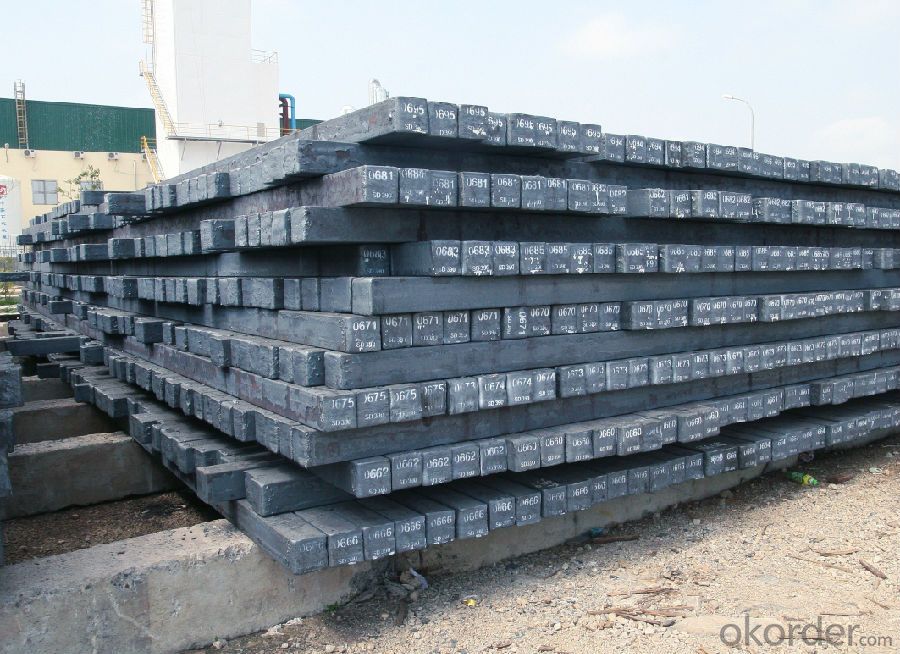
Specifications of Square Steel Billet Q235 Grade Prime Quality 5#
| Standard | C(%) | Mn(%) | S(%) | P(%) | Si(%) |
| Q195 | ≤0.12 | ≤0.50 | ≤0.040 | ≤0.035 | ≤0.30 |
| Q235 | ≤0.20 | ≤1.40 | ≤0.045 | ≤0.045 | ≤0.35 |
| Q275 | ≤0.22 | ≤1.50 | ≤0.045 | ≤0.045 | ≤0.35 |
| 20MnSi | 0.17-0.25 | 1.2-1.6 | ≤ 0.050 | ≤ 0.050 | 0.40-0.80 |
| 3SP | 0.14-0.22 | 0.40-0.85 | ≤ 0.050 | ≤ 0.040 | 0.05-0.15 |
| 5SP | 0.28-0.37 | 0.50-1.00 | ≤ 0.050 | ≤ 0.040 | 0.15-0.30 |
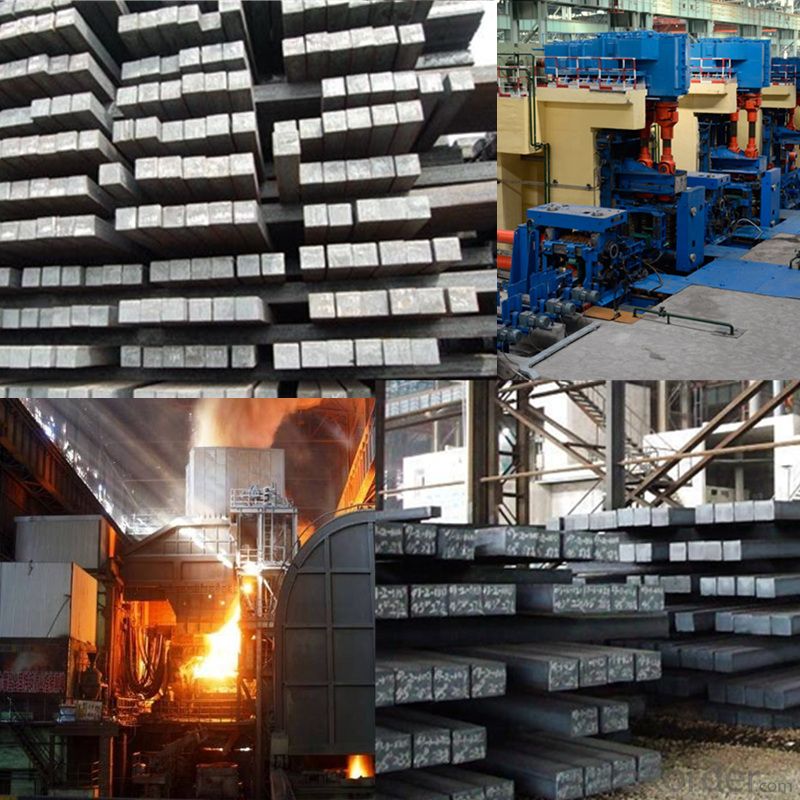
FAQ of Square Steel Billet Q235 Grade Prime Quality 5#
We have organized several common questions for our clients,may help you sincerely:
1. How Can I Visit There?
Our company is located in Tianjin City, China, near Beijing. You can fly to Tianjin Airport Directly. All our clients, from home or aboard, are warmly welcome to visit us!
2. How Can I Get Some Sample?
We are honored to offer you sample.
3. Why choose CNBM?
Our delivery time about 15-20days for standard sizes, if you have other requirements like hardness, quanity and width ,it is about 20-40days. But don't worry we also try our best for the delivery time ,because time longer and our cost is higher.
- Q: What are the main factors affecting the thermal conductivity of steel billets?
- The thermal conductivity of steel billets is primarily influenced by several factors. Firstly, the chemical composition of the steel plays a significant role in determining its thermal conductivity. Elements such as carbon, manganese, and silicon can affect the crystal structure and the arrangement of atoms within the steel, which in turn influences its ability to conduct heat. Generally, steels with a higher carbon content have lower thermal conductivity due to the increased presence of impurities and the formation of non-conductive carbides. Secondly, the microstructure of the steel also affects its thermal conductivity. Heat conduction in steel occurs through the movement of lattice vibrations, known as phonons. The presence of grain boundaries, dislocations, and other defects within the microstructure can impede the phonon movement, resulting in reduced thermal conductivity. Conversely, a more uniform and fine-grained microstructure tends to enhance thermal conductivity. Furthermore, the temperature of the steel billet can significantly impact its thermal conductivity. As the temperature increases, the thermal conductivity of steel generally decreases due to the increased scattering of phonons by lattice vibrations and the accompanying rise in thermal resistance. Another factor that influences the thermal conductivity of steel billets is their physical dimensions, particularly their cross-sectional area and length. The larger the cross-sectional area, the higher the thermal conductivity, as there is more space available for the heat to transfer through. Similarly, longer billets tend to have lower thermal conductivity due to the increased distance over which heat must be conducted. Lastly, the presence of impurities and alloying elements in the steel can also affect its thermal conductivity. For example, alloying elements like nickel, chromium, and copper can alter the crystal structure and lattice vibrations, thereby influencing the thermal conductivity of the steel billet. In summary, the main factors affecting the thermal conductivity of steel billets include the chemical composition, microstructure, temperature, physical dimensions, and the presence of impurities and alloying elements. Understanding these factors is crucial in various industrial applications where heat transfer and thermal management play a critical role.
- Q: What are the main challenges in steel billet production?
- There are several main challenges in steel billet production that manufacturers and producers face. One of the key challenges is ensuring consistent and uniform quality of the billets. Steel billets are the semi-finished products that are further processed into various steel products, and any inconsistency or variation in their quality can lead to defects or failures in the final products. Therefore, maintaining strict quality control measures throughout the production process is crucial. Another significant challenge is optimizing the production process to meet the desired quantity and quality targets while minimizing costs. This involves efficient utilization of resources such as raw materials, energy, and labor. Additionally, maintaining a balance between the production speed and quality can be challenging as increasing the speed may lead to reduced quality or increased defects. Ensuring the safety of workers and the environment is also a major challenge in steel billet production. The production process involves heavy machinery, high temperatures, and potentially hazardous materials, which can pose risks to the workers' health and safety. Implementing proper safety protocols, providing training, and ensuring compliance with regulatory standards are essential to address these challenges. Furthermore, meeting the ever-increasing demand for steel billets is a challenge for producers. The market demand fluctuates, and manufacturers need to be able to adjust their production capacity accordingly. This requires flexibility in production planning and efficient inventory management to avoid overproduction or stock shortages. Lastly, technological advancements and innovations in the steel industry pose both challenges and opportunities. Adopting new technologies, such as automation, artificial intelligence, and data analytics, can improve efficiency and productivity. However, incorporating these technologies into existing production processes can be complex and require significant investments and expertise. In summary, the main challenges in steel billet production include maintaining consistent quality, optimizing production processes, ensuring safety, meeting market demand, and adapting to technological advancements. Overcoming these challenges requires continuous improvement, innovation, and a proactive approach to stay competitive in the steel industry.
- Q: What is the standard size of a steel billet?
- The standard size of a steel billet can vary depending on the specific requirements and industry standards. However, in general, steel billets are typically rectangular in shape and have dimensions ranging from 100mm x 100mm to 200mm x 200mm. The length of a steel billet can also vary but is commonly around 6 meters. It is important to note that these dimensions are not fixed and can be customized based on the intended use and manufacturing process.
- Q: How do steel billets contribute to the construction of bridges and infrastructure?
- Steel billets are essential to the construction of bridges and infrastructure as they serve as the raw material for manufacturing various structural components. These billets, which are heated and then shaped into desired forms, provide the necessary strength and durability required to withstand heavy loads and harsh environmental conditions. They are frequently used to fabricate beams, columns, and other critical elements that make up the skeletal framework of bridges and infrastructure projects. Additionally, steel billets can be further processed to produce reinforcing bars, which enhance the structural integrity of concrete structures, such as foundations and roadways. Overall, steel billets play a vital role in ensuring the structural stability and longevity of bridges and infrastructure, making them indispensable in the construction industry.
- Q: What are the different methods of steel billet cutting and machining?
- Steel billets can be cut and machined using several different methods, each with its own advantages and applications. Some of the most commonly used methods include: 1. Sawing: To cut through a steel billet, a saw blade is employed. This method is relatively straightforward and cost-effective, making it suitable for cutting large quantities of billets into desired lengths. However, it may result in rough edges and necessitate additional finishing processes. 2. Flame cutting: Also known as oxy-fuel cutting, this method involves using a combination of fuel gas and oxygen to create a high-temperature flame that melts and cuts through the steel billet. It is effective for cutting thick billets and can achieve a high level of precision. Flame cutting can be carried out manually or using automated machines. 3. Plasma cutting: This method utilizes a plasma torch to generate a high-velocity jet of ionized gas that melts and cuts through the steel billet. It is particularly effective for cutting through thick materials and intricate shapes and curves. Plasma cutting provides high cutting speeds and excellent precision. 4. Waterjet cutting: In this method, a high-pressure jet of water mixed with abrasive particles is used to cut through the steel billet. Waterjet cutting is versatile and can handle various materials, including steel, without generating heat-affected zones or causing distortion. It is ideal for cutting complex shapes and thin materials. 5. Laser cutting: Laser cutting involves the use of a high-powered laser beam to melt and vaporize the steel billet along a predefined path. This method offers exceptional precision and enables intricate and complex cuts. Laser cutting is commonly used for thin to medium thickness billets and is suitable for both small-scale and industrial applications. In addition to these cutting methods, there are various machining processes that can be applied to steel billets, such as milling, turning, drilling, and grinding. These processes involve removing material from the billet to achieve desired shapes, dimensions, and surface finishes. The choice of machining method depends on factors such as the complexity of the part, required tolerances, and production volume. Overall, the different methods of steel billet cutting and machining provide a range of options for manufacturers to effectively shape and process steel billets according to their specific requirements.
- Q: What are the main factors affecting the ductility of steel billets?
- There are several main factors that affect the ductility of steel billets. Firstly, one of the most significant factors is the carbon content in the steel. Higher carbon content generally reduces ductility and makes the steel more brittle. This is because carbon atoms tend to form strong bonds with iron atoms, resulting in a harder and less malleable material. Secondly, the composition of other alloying elements in the steel can also influence ductility. Elements such as manganese, silicon, and phosphorus can have different effects on the steel's ductility depending on their concentration. For example, manganese can enhance ductility while phosphorus can decrease it. Thirdly, the heat treatment process can have a significant impact on the ductility of steel billets. Rapid cooling, known as quenching, can increase the strength of the steel but may also reduce its ductility. On the other hand, annealing, which involves heating the steel and then slowly cooling it, can improve the ductility of the material. Additionally, the presence of impurities and defects in the steel can affect its ductility. Inclusions, such as non-metallic particles, can act as stress concentrators and reduce the material's ability to deform plastically. Similarly, cracks, voids, and other defects can also weaken the steel and decrease its ductility. Lastly, the grain size of the steel can influence its ductility. Fine-grained steels tend to have higher ductility compared to coarse-grained ones. This is because smaller grain boundaries provide more obstacles for dislocation movement, leading to increased resistance to deformation. Overall, the ductility of steel billets is influenced by various factors, including carbon content, alloying elements, heat treatment, impurities and defects, and grain size. Understanding and controlling these factors is essential for ensuring the desired ductility properties of steel.
- Q: What is the weight of a standard steel billet?
- The weight of a standard steel billet can vary depending on its dimensions, but typically ranges from 1 to 6 metric tons.
- Q: How are steel billets used in the manufacturing of oil and gas equipment?
- The production of oil and gas equipment heavily relies on steel billets. These semi-finished steel products act as the foundation for creating various equipment used in the oil and gas industry. Steel billets are primarily used in pipe manufacturing. To withstand high pressure, extreme temperatures, and corrosive environments, oil and gas pipes require raw materials that can meet these demanding requirements. Steel billets are heated, pierced, and elongated through extrusion to form seamless pipes. Alternatively, they can be rolled and welded to create longitudinally welded pipes. Additionally, steel billets are essential in the production of valves, fittings, and flanges. Valves are critical in controlling the flow of oil and gas, while fittings connect pipes and change their direction. Flanges provide a means of connecting pipes, valves, and other equipment through bolting. All of these components require steel billets as a starting material, which are then machined, shaped, and heat-treated to meet necessary specifications. Furthermore, steel billets are utilized in the fabrication of drilling equipment and offshore structures. Drilling equipment, including drill bits, drill collars, and drill pipes, are vital for oil and gas exploration and extraction. High-quality steel billets are crucial to ensure the strength and durability of these components, which endure intense forces and harsh conditions. Offshore structures, such as platforms and rigs, also rely on steel billets to construct frameworks and support systems that withstand the challenging marine environment. In conclusion, steel billets are irreplaceable in the manufacturing of oil and gas equipment. They serve as the raw material for pipes, valves, fittings, flanges, drilling equipment, and offshore structures. By starting with high-quality steel billets, manufacturers can produce durable and reliable equipment capable of withstanding the demanding conditions of the oil and gas industry.
- Q: What industries use steel billets?
- Several industries use steel billets, including automotive, construction, manufacturing, and infrastructure. Steel billets are commonly used as raw material in the production of various metal products such as pipes, rods, bars, wires, and sheets. They are also utilized in the construction of bridges, buildings, and other structural components. The automotive industry uses steel billets for manufacturing parts like engine blocks, chassis, and suspension components. Additionally, steel billets find applications in the energy sector, machinery production, and shipbuilding.
- Q: How are steel billets cooled after the manufacturing process?
- After the manufacturing process, steel billets undergo a cooling procedure called water quenching, which involves immersing them in a water bath or spraying high-pressure water onto them. By rapidly cooling the billets, the microstructure of the steel is controlled, resulting in desired properties like increased strength and hardness. Water quenching is favored for its efficient and uniform cooling, ensuring consistent quality in the billets. Moreover, it is a cost-effective option compared to other cooling methods. However, it is worth noting that the cooling process may differ depending on the specific requirements of the steel being produced, leading to the utilization of alternative cooling methods like air cooling or oil quenching.
Send your message to us
Square Steel Billet Q235 3SP Grade Prime Quality 5#
- Loading Port:
- Tianjin
- Payment Terms:
- TT OR LC
- Min Order Qty:
- 2000 m.t
- Supply Capability:
- 50000 m.t/month
OKorder Service Pledge
OKorder Financial Service
Similar products
Hot products
Hot Searches
Related keywords
